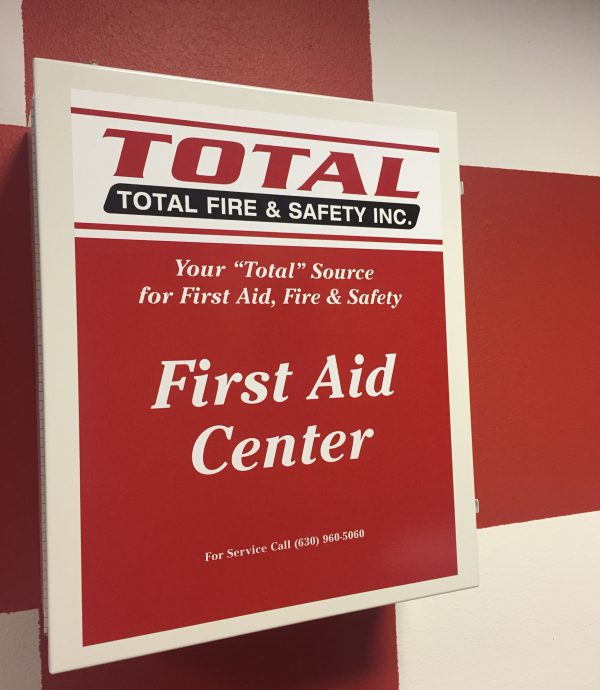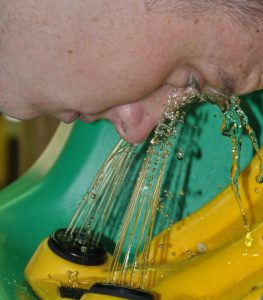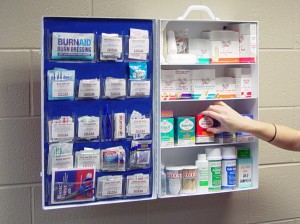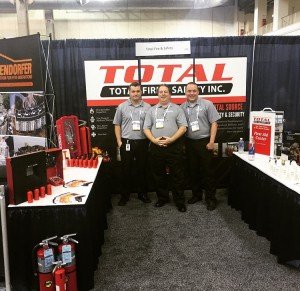-
March 17, 2020 by Total Fire and Safety

By now, most Americans are aware that you cannot contract the Coronavirus by drinking a Corona beer! We also know that the Coronavirus outbreak, that began in Wuhan, China, has spread across 27 countries including the United States. It is estimated that over 87,000 people are infected with the coronavirus or COVID-19 and numbers continue to climb. Much is unknown about the virus that causes COVID-19, but Doctors and scientists are drawing knowledge from similar coronaviruses and are working on a vaccine. What is the coronavirus and how can you as a business, keep employees healthy?
What is the Coronavirus(COVID-19)?
According to the CDC (Center for Disease Control), Coronaviruses are a large family of viruses that are common in humans and many different species of animals, including camels, cattle, cats, and bats. The virus that causes COVID-19 is spreading from human to human and causes with respiratory infections, like the common cold. The infection can become severe when it turns into pneumonia. One of the challenges to this virus is that symptoms may not show for two weeks, making it easy to spread.
What Can Employers do to Keep Employees Healthy?
The following is the CDC’s recommendation for businesses to create a healthy work environment.
1. Encourage sick employees to stay home. Employees should be fever free for 24 hours without the use of fever reducing medication. Stay flexible when it comes to sick leave, i.e., not requiring a healthcare provider note to stay off work. Provide job security and/or remote access when/if they need to stay home.
2. Encourage clean hands. Provide touch-free sanitizer dispensers, cleansing wipes, soap and water etc. Place informational posters throughout the workplace that encourage healthy precautions. Instruct employees to use hand sanitizers or wash hands with soap for at minimum 20 seconds.
3. Enforce Coughing Etiquette. Emphasize the need to cover mouths with arm when coughing or sneezing.
4. Quarantine sick employees. If employees come to work sick or become ill while at work, separate them from the rest of the population and send them home.
5. Sanitize touch points daily. Routinely clean doorknobs, buttons, switches, handles etc.(Any area frequently touched). Have readily available disposable wipes near commonly used surfaces.
6. Stress caution to employees traveling in or outside the country. If employees become ill while traveling, advise them to contact a healthcare provider immediately. Employees who show symptoms of illness prior to traveling should stay home.
A first aid kit can help!
A first aid kit should always be on hand for any business, but with a new virus in town, its value is even greater. Basic first aid kits contain items like pain relievers and fever reducers, antacids, and bandages to keep employees comfortable and on the job. Other items in a typical OSHA-required first aid kit can also come in handy to help employees fend off coronavirus:
Wound cleaning agents such as sealed moistened towelettes can be used to disinfect surfaces.
Latex gloves can come in handy to touch necessary items that may be infected
Resuscitation equipment such as resuscitation bag, airway, or pocket mask
Meanwhile, those with symptoms can make good use of other OTC supplies: Aspirin, Ibuprofen, Acetaminophen and Decongestants
Total Fire and Safety can assist your business in preparing for the coronavirus or any other emergency that may occur by servicing your first aid kit. Together we can fight this epidemic and keep one another healthy Give Total Fire and Safety a call today! (630)960-0560.
Category: Business Safety, Client Events, First Aid, First Aid Kits, Health and Safety Tags: commercial first aid kit, fire and safety needs, first aid, first aid supplies, lifesafety | Comments Off on Can You Protect Employees from the Coronavirus?
-
November 12, 2019 by Total Fire and Safety

Does your organization have a first aid kit hanging on the wall? It sits there silently like a dutiful soldier, ready and waiting for any emergency. But with winter on its way, you may be surprised at how often that first aid kit can be called into service during the coldest months of the year.
Winter weather can easily compromise employee safety, whether the workplace is outdoors or in an office. It is important to keep first aid kits well stocked with winter safety essentials. Before you start planning your holiday office party, let’s look at your first aid kit and what we can do to “winterize” it.
OSHA has established a list of required first aid supplies for the workplace. Depending on the business and specifics of the environment, there are different first aid requirements. Employers are responsible for keeping the first aid kit stocked and up to date with the necessary supplies needed. They include:
- Band-aids, Elastic Bandages/Adhesive Tape, Sterile Gauze Pads/Rolls and Large Pressure Bandages in different shapes and sizes of bandages for possible falls, cuts, and scrapes. The opening of cracked, chapped winter skin can precipitate the need for a band-aid or a fall on the ice can merit more serious first aid treatment.
- Non-Latex Gloves, Antiseptic wipes, Peroxide and Alcohol and Triple Antibiotic Ointment will help keep those helping tend a wound safe, and also help the wound heal more quickly. Protect skin from contamination.
- Eye Pads and Eye Wash can help tend weather-related discomforts on the way into work.
- Tongue Depressors can be used to check throat irritations during winter flu season or be used as splints for possible weather-related injuries.
- CPR Shields can protect users from bodily fluids when CPR is essential. In winter, shoveling and overexertion in the cold can lead to cardiac arrest and the need for onsite CPR. Total Fire & Safety can help with employee training in this area.
- Triangular Bandages can be onsite in the event of the need for a sling or tourniquet. Falls on ice or minor accidents may require such dressings.
- Cold Packs: Instant cold packs help with sprains, fractures, burns, etc.… common injuries associated with falls, accidents, or overheating.
- Thermometer: Determines body temperatures. The flu and other winter maladies can be contagious! Detecting an above normal temperature in an employee can prevent an outbreak that can take down a workplace.
- Aspirin, Tylenol, or Motrin can help alleviate the symptoms of a cold.
- Penlight can be used to look in ears and throats for maladies, or even pupils for possible concussion victims.
- Antihistamine Tablets and Hydrocortisone to quell the allergies and dermatitis from the dry air, increased dust, and lack of fresh air during the winter months.
- Blankets to use in emergencies, such as frostbite, hypothermia, etc.
For any company, the first aid kit can be your first offense against the common winter injuries that employees can suffer en route or while at work:
Sprains and Broken Bones
Ice covered roadways, sidewalks, parking lots, and driveways put you at risk for a nasty fall which can result in a sprain or broken bone. If the injury is minor and does not require an immediate doctor’s care, delve into your first aid kit and treat the injury with RICE:
1. Rest the injured limb with crutches, a sling, or splint, or anything you can to keep from putting stress on it.
2. Ice the injured limb. Apply a cold pack to the area to prevent swelling.
3. Compress the injury by wrapping a bandage around it or use a sleeve.
4. Elevate the injured limb above the heart to reduce swelling.
In addition, offer the victim Tylenol, Aspirin, or Motrin for pain and swelling.
Frostbite
Frostbite occurs when skin cells and tissues freeze, damaging the skin walls. Most often it happens to fingers, toes, noses, cheeks, chin, ears, and the areas with most exposed skin. If frost bite should happen, remove the victim from the cold. Warm their hands by tucking them under the armpits. Cover the nose, ears, and face and remove any wet clothing. Once in warm shelter, place frostbitten areas under warm, not hot, water. Avoid direct heat. Treat pain with Tylenol, Aspirin, or Motrin from your first aid kit. If blisters or numbness continues, seek medical attention.
Hypothermia
Hypothermia happens when the body’s internal temperature drops below 95 degrees. Call 911 immediately. A person’s breath can become shallow or they can stop breathing all together. If this happens, CPR must be administered using a CPR shield from your first aid kit. If CPR is not necessary, get the person away from the cold and wrap them in a blanket, also in your first aid kit. Apply a warm compress to the chest, neck, groin, and head.
Winter weather can be dangerous and serious injuries can occur, beyond what a first aid kit is capable to handle. Assess the situation and call 911, if needed, first.
Total Fire and Safety can help you keep your first aid kits stocked appropriately and provide on-site first aid training for employees. Be prepared for winter! Give us a call today! (630)960-5060.
Category: Business Safety Tags: commercial fire protection, commercial fire safety, fire and safety solutions, first aid, first aid supplies, Total Fire & Safety | Comments Off on Fighting Winter Ills with the Company First Aid Kit
-
May 20, 2019 by Total Fire and Safety

(Photo credit: Dreamstime ID 95654936 © Wavebreakmedia Ltd | Dreamstime.com)
With the rise in popularity and construction of senior living centers, fire safety continues to be a concern to keep our grandparents, parents, and aging loved ones protected. According to the United States Fire Administration, in 2015, older adults represented 15 percent of the U.S. population and suffered 40 percent of all fire related deaths. They are also 2.7 times greater risk of dying in a fire than the total population. Those 85 and older were 3.8 times more likely to die in a fire than the total population.
The elderly in multi-level dwellings are at higher risk of dying in a fire for several reasons. They may be on medication that impairs them from taking stairs down to safety, or their mobility issues may prevent them from moving quickly enough. They may live alone or have no one to call for assistance. Educating property managers, caretakers, and the elderly on fire safety for senior citizens is one step we can take in protecting this aging generation. Below are some considerations for property managers and their tenants.
1. Test Smoke Alarms
Smoke is a silent killer. Senior citizens with hearing problems who sleep without a hearing aid could be killed in their sleep. Having a working smoke alarm in every room and hallway helps, but they should be effective for the user. Strobe alarms are best, and seniors can install alarms that shake their bed to rouse them in the event of a fire. Most importantly of all, make sure to test smoke alarms every month so they are always in compliance.
2. Sit Your Butt Down…in the proper place!
Smoking is the number one cause of fire deaths in the country. Remind senior citizens never to smoke in bed and especially not near flammable oxygen tanks. Seniors can use deeper or heavier ashtrays to avoid ashes flipping or falling onto the rug and starting a fire. The best way to put butts out is with sand and water.
3. Create a Fire Escape Plan
Seniors may have less than three minutes to escape danger in the event of a fire. They should have a fire escape plan and practice it, knowing all the accessible exits. For seniors suffering from dementia or Alzheimer’s who have escape proof doors, it is important they have a prearranged escort in the event of a fire.
4. Stay in the Kitchen
Seniors should always stay in the kitchen when cooking. Most kitchen fires begin because food is left unattended, so if they must leave the kitchen while cooking they should turn the burner off. Even a short absence from the kitchen can unexpectedly turn into an extended amount of time away. If seniors must leave the kitchen, they should take a cooking utensil or potholder with them to serve a helpful reminder. Also, remind seniors to never cook with loose or dangling sleeves that can easily ignite and burn a senior, or potentially start a major fire.
5. Daily Necessities
Seniors should think about what they use to get around every day, like glasses, a wheelchair, a cane, etc. These items should be placed next to the bed for easy access in case of fire. A phone and a whistle should also be at bedside. The whistle lets people know where you are and enables you to warn others of the fire. Escape is always the priority; call the fire department later. If trapped, use the phone to call for help. Seniors with wheelchairs or walkers should check exit routes ahead of time to be sure they are accessible or plan an alternate route. Inform building managers or neighbors of the plan. If your impairment makes it impossible to escape in the event of a fire, discuss your concern with landlord, or check with the fire department.
6. Don’t Overload Outlets or Extension Cords
Inspect your extension cords regularly for fraying, exposed wire, or loose plugs. Unplug extension cords when not in use. If you need to plug in multiple appliances, use an extension cord approved by the Underwriter’s Laboratories (UL), a nationally recognized testing laboratory.
As their population begins to grow, fire safety for senior citizens cannot be stressed enough. Property managers, caretakers, the elderly, and their families should all be aware of the increased risk to the age group and try to protect them. The professionals at Total Fire and Safety are ready to help ensure your building has fire equipment that is working properly. We provide the life safety features that keep fire safety for your residents, including senior citizens, a main priority. Give us a call today! 630-960-5060
Category: Fire Alarm Monitoring, Fire exits, Fire Extinguishers, Fire Safety, Total Fire and Safety, Uncategorized Tags: fire and safety solutions, Fire Extinguisher, fire safety, fire safety solution, fire safety training, fire training, first aid, lifesafety, Total Fire and Safety, wireless fire alarm monitoring | Comments Off on Fire Safety for Senior Citizens
-
January 23, 2019 by Total Fire and Safety

Commercial first aid kits don’t have to be costly. Yet, when you start to compare commercial first aid providers, you will see some radical differences in pricing. Many first aid service companies find creative ways to drive up costs for their customers. At Total Fire & Safety, our customers never have to worry about “hidden costs” because there are none! Knowing what your company needs and being sure you are not paying for more can help your overall first aid budget and ensure you have the right first aid provider on your side. Here are some tips on hidden fees so you can avoid any surprise charges from your first aid service company.
- Make sure you know what is going in the box.
It is possible that you don’t need many of the supplies the service stocks in your cabinet. Depending on your workplace, employees can experience minor cuts etc. However, overstuffing a kit with odd size bandages and unnecessary items like hand lotion, lip ointment, dental cream, etc. helps a company justify a higher invoice. At Total Fire and Safety we stock what is required by OSHA and what is directed by the client. No redundant or unnecessary items.
- Make sure you are not getting charged extra for “normal” items.
Some companies charge extra for special items, like disinfectant wipes. Check your invoices! There are no surprises with TFS.
- Make sure you are not getting charged for additional representatives.
Some first aid companies have separate reps for stations, for example, first aid kits and eyewash stations. At TFS, your single representative is knowledgeable about all your first aid needs to streamline costs and deliver consistent quality service.
- Make sure the first aid service meets ANSI requirements.
ANSI (American National Standards Institute) puts together the requirements for first aid supplies in the workplace. They provide a specific list for first aid kits. A service company might overlook this list in order to stock a kit with many unnecessary various types of items. At Total Fire and Safety, we provide supplies required by ANSI as well as OSHA.
- Make sure you understand the fees on the invoice.
Do you see service or delivery charges, overstocking or restocking fees? First aid service companies pile these costs into an unreadable invoice. TFS does not charge service fees, fuel, or delivery charges. We only charge for items that employees have used. Have a question about the bill? TFS is there to answer any concerns.
There are many services companies in business to make a buck at the expense and well-being of your company. You should not have to choose between a safe work environment and a cheaper bill. TFS recognizes the importance of a healthy workplace combined with the affordability of superior service. TFS never overcharges, overstuffs, or places hidden fees with in a first aid kit. We provide the right supplies to keep employees safe at work while always keeping costs down. For more than 30 years, Total Fire and Safety has been providing OSHA approved first aid kits and replenishment to businesses. If we can help with your first aid needs, contact us today at 630-960-5060.
Category: Business Safety, First Aid, First Aid Kits, Total Fire and Safety Tags: fire and safety needs, fire safety, first aid, first aid supplies, Total Fire & Safety | Comments Off on Avoiding the Hidden Costs of Commercial First Aid Kits
-
December 4, 2018 by Total Fire and Safety

A brand new year is a great time for businesses to evaluate what they can improve upon, even in terms of their commercial fire safety. No business is completely immune to accidental fires and having the right equipment in place year round can prevent potential devastation.
According to the National Fire Protection Association (NFPA), more than 3,300 fires break out in office buildings across the U.S each year. The NFPA reports that a number of people are killed or injured with an estimated $112 million in property damage.
If you’re a business set on achieving your 2019 goal of reaching NFPA compliance, take a look at checklist of equipment you need below for commercial fire safety. Anything missing? Call Total Fire & Safety. We can help!
____ Alarms
____ Extinguishers and Suppression Systems
- Conduct tests regularly to ensure function and pressure when activated.
- Schedule routine maintenance of equipment.
- Store extinguishers in open areas for easy access.
____ Emergency Lighting
- Effective emergency lighting throughout the building will help occupants to safety in an emergency.
- Schedule regular maintenance and inspections.
Equipment is essential and necessary to prevent major damage but people are too! Whether it’s putting out a fire or tending to the injured, what good is the equipment if you don’t have employees able to use it?
____ First Aid
____ Training Courses
- A comprehensive fire equipment training course on the use of fire equipment and first aid can place confidence in employees and keep everyone safe.
- Training employees reduces the chance of small fires starting and spreading.
You could have all the equipment ready and employees trained to use it but they need something else.
____ Emergency Preparedness Plan
- Remind employees to REACT-(remove from danger, ensure doors/windows are closed, activate alarm, call 911, treat as dangerous.)
- Conduct fire drills.
- Schedule inspections of all fire equipment.
- Have employees trained on firefighting equipment.
Making sure you have commercial fire safety in place can seem a daunting task but the pros at Total Fire and Safety are here to simplify it. TFS covers everything including inspection, maintenance, training, and keeping your building up to code so you are well protected in the event of an unforeseen fire. Give us a call today at 630-960-5060.
Category: Business Safety, Fire Alarm Monitoring, Fire Equipment Inspections, Fire exits, Fire Extinguishers Tags: commercial fire protection, commercial fire safety, commercial first aid kit, emergency exit lights, emergency lighting, fire and safety solutions, Fire Extinguisher, fire safety, fire safety training, fireextinguisher, firesafetytraining, firesprinklerinspections, first aid | Comments Off on The Business Owner’s Checklist for Commercial Fire Safety in 2019
-
November 5, 2018 by Total Fire and Safety

Next to the everyday hustle and bustle of the average office, office kitchen fire safety is a secondary concern. However, the National Fire Protection Agency (NFPA) reports that just over one-fifth of office fires begin in the kitchen or cooking area. Twenty-nine percent are started by cooking equipment, the leading cause of fires in the office. Although these fires started small, they caused major structure damage.
With the holidays on the way and more employee parties sure to take place, the office kitchen will be used more than ever. How can you prevent a fire from happening? How do you keep your employees safe and well fed at the same time? Here are four important safety tips to help you get started:
1. Replace worn or frayed power cords.
Inspect power cords on the kitchen appliances. Are the wires exposed? If so, the cord can short out and cause a fire. Encourage your employees to keep an eye out for damaged cords. Be sure to replace them as soon as they are found. This one simple act will keep the office safe.
2. Watch food as it cooks.
It easy to become distracted in the office, whether its fellow coworkers gossiping or doing too many things at once. You wouldn’t leave food unattended at home and the office should not be any different. To ensure food cooks properly, emphasize that employees must stay near appliances as they cook or heat food/beverage. Employees using the kitchen also need to watch for signs of smoke or burning. Doing so will ensure the safety of the entire building.
3. Regularly clean appliances.
We’ve all been there. We stick a (insert food item) in the microwave, oven, toaster, etc., and it explodes or leaves spillage behind. However, we avoid cleaning, commonly thinking someone else will do it. Spills and baked-in foods left behind can cause a fire. Cleaning kitchen equipment after use will prevent grease from accumulating which prevents combustion. These hazards can be avoided easily so remind employees to wipe up spills, food particles left behind, etc.
4. Have employees trained to use a fire extinguisher.
No matter how proactive you and your employees are, accidents still happen. Having staff trained to use fire fighting equipment could mean the difference between a catastrophe or a minor incident. Total Fire and Safety can train you and your employees to use a fire extinguisher, first aid equipment, and other lifesaving safety measures.
With most office fires starting in the kitchen, it is important to educate employees on office kitchen fire safety. Total Fire and Safety (TFS) offers a complete fire training program to educate employees on the proper techniques of fighting a fire. Not only can your employees use these practices in the office, they can also apply them in their home. Keep you, your staff, and your workplace fire safe. Give TFS a call today at 630-960-5060.
Category: Business Safety, Fire Extinguishers, Fire Safety, First Aid, First Aid Kits Tags: commercial fire safety, fire and safety equipment, fire and safety needs, fire and safety solutions, Fire Extinguisher, fire safety, fire safety solution, fireextinguisher, firesafetytraining, first aid | Comments Off on Danger on the Job: Keeping the Office Kitchen Safe
-
December 19, 2017 by Total Fire and Safety
 If you have hazardous chemicals onsite, you likely need an emergency eyewash station. One of the many vital services we provide at Total Fire and Safety is performing inspections on emergency showers and eye wash stations. Like any fire or safety equipment, routine inspections are a must to ensure your equipment will perform perfectly at a moment’s notice. In an emergency situation, nobody has the time troubleshoot an underperforming piece of equipment, let alone attempt to repair it. We’ve outlined the steps we take to ensure your eye wash station or emergency shower is ready in an emergency:
1. Ensure everything about the station’s location is correct. We first make sure the station is in an area it is needed. A working emergency eye wash station is of no use if it is not accessible to those who may need it. While showers tend to be fixed structures, eye wash stations can be either fixed or mobile. We also make sure the station is unobstructed and away from any source of debris or hazardous spray, which could compromise its usefulness.
2. Next, we inspect the exterior. We visually check every part of the station for any signs of damage, such as leaks, cracks, or other signs. Then, we check that all the hardware is intact and correctly in place, such as the caps, valves, and pull rods for showers. We then verify everything is at the correct height and that all signage is in its proper place before moving on to the next step.
3. After the visual inspection, we test the operation. For every eye wash station, we check the flow of water by gauging its height, volume, and response time from the moment of activation. For showers, we verify the water flows properly and onto the correct area.
4. For portable units, we empty and replace the water. This is to ensure the water in the reservoir is not only full, but clean and fresh. This step is also taken so that we can rinse out the inside as well as check for foreign debris or contaminants which could compromise the integrity of the eye wash station.
5. Finally, we clean everything and document the inspection. This entails wiping everything down with a rag and cleaning solution. Once this is done, we apply the inspection tag to the station to communicate to others when the inspection took place and what was performed. We also keep our own records of the inspection by filling out detailed information in an eyewash report.
In any facility that may contain hazardous substances, you may find an emergency shower or eye wash station idly waiting until needed. These units are not given much thought, but anyone who has ever used one in an emergency situation will vouch for its importance to stay in proper working order. If you have any questions or concerns about your emergency eye wash station or shower, or about the readiness of any of your fire safety equipment, please contact us.
Category: First Aid, Health and Safety, NFPA Compliance, Total Fire and Safety, Uncategorized Tags: fire and safety equipment, first aid, first aid supplies, Health and Safety, Total Fire & Safety | Comments Off on Are Your Emergency Eye Wash Stations Ready for Action?
-
April 19, 2017 by Total Fire and Safety

We cannot overstate the importance of first aid requirement for the workplace. If you read through the OSHA requirements for first aid kits and first aid training, and the ANSI minimum first aid equipment for businesses, you may notice that a lot of the details are left up to the business owner. That is because every business is different, and will have different risks depending on the equipment involved in the business. A simple office space might have a small, basic first aid kit, while a car mechanic would probably need a much more complex one. Here are five steps to help guide you through the process of determining what first aid kit and training your business and your employees need.
1. What are the most common injuries in your industry? Think about the equipment involved with your industry, and what kind of accidents can happen with that equipment. Make sure you satisfy the first aid requirement for workplace accidents to handle the most probable injuries within your specific business.
3. How close are you to the nearest hospital or medical center? In the event of an emergency, how long would it be until help arrived? If your business is in a remote location, you might need extra first aid materials to handle an emergency for a longer length of time.
4. How many employees do you have? Make sure there are enough first aid kits to handle an emergency where multiple people are injured. The more employees you have, the more first aid kits you should have.
5. Consider the layout of your workplace. Make first aid kits easy to get to, and easy to see. They must be clearly labeled, and all employees should know where they are. Also make sure that the first aid kits are accessible in the areas which are most prone to accidents, such as the kitchen in a restaurant.
There are a lot of options for both first aid kits and training. Make sure to think about restocking first aid kits and offering training to new employees. First aid requirements for workplace accidents can include portable kits or wall mounted kits, designed for indoor or outdoor use. For first aid training programs, make sure you go with a quality program that will teach your employees how to handle emergencies that are most likely to occur in your workplace. Cover the basics, and go beyond, to keep your employees healthy and safe.
If you have questions or concerns about first aid kit or training compliance, Total Fire and Safety is you one-stop source for all fire safety and first aid needs. Feel free to contact us at 630-960-5060.
Category: Uncategorized Tags: commerical first aid, commerical first aid kit, fire and safety equipment, fire and safety needs, fire safety, first aid, first aid kit, first aid safety, first aid supplies, safety, Total Fire & Safety | Comments Off on Five Questions to Ask to Assess Your First Aid Requirement for Workplace
-
February 26, 2016 by Total Fire and Safety
 You may think you know the importance of first aid and fire safety, but the real impact of first aid and fire equipment training in the workplace is often overlooked. Whether your business is a high or low-risk environment, there are always risks that can lead to medical emergencies. You may think you know the importance of first aid and fire safety, but the real impact of first aid and fire equipment training in the workplace is often overlooked. Whether your business is a high or low-risk environment, there are always risks that can lead to medical emergencies.
1. Increasing profitability. A safer workplace means less missed workdays due to injuries. According to the National Safety Council, in 2012, nearly 5 million workers were injured at work, which costed employers a total of $198.2 billion.
2. Saving your employees time and money. It is proven that businesses and employees will save money if accidents are handled quickly and effectively. The National Safety Council attests that 25 percent of all emergency room visits can be avoided with basic first aid and CPR certification.
3. It really does save lives. If your employees don’t know how to handle injuries, the condition of the victim could worsen before the ambulance arrives, and cause further trauma and debilitation, not to mention medical costs and possibly, even death. Having a commercial first aid kit on the job sends a message to your employees that you value their health and well-being and are doing all you can to mitigate any injuries that occur on the job. It also shows that you never want your employees to be vulnerable to unattended injury.
4. It is required by law for many workplaces. The Occupational Safety and Health Administration requires businesses to provide first aid and CPR training to employees if there is no nearby clinic or hospital. Make sure you also have a commercial first aid kit available in your workplace. Obviously, if your business deals with risky materials or conditions, having a commercial first aid kit makes sense whether or not you are bound by law.
5. Teach your employees how to use emergency equipment. You spend money keeping your workplace up to code with commercial fire extinguishers and first aid kits, but these things don’t handle emergencies by themselves! Your employees need to know how to work fire extinguishers and use first aid supplies correctly. The investment need not be costly; a simple on-site class with the staff in attendance should suffice.
Total Fire & Safety can handle all your needs whether it be fire extinguishers, first aid kits, fire extinguisher training, or first aid training. For more information, visit our website or you can contact us at 630-960-5060.
Category: Fire Extinguishers, Fire Safety, First Aid Kits, Total Fire and Safety Tags: fire safety training, fire training, first aid, first aid kit, first aid training, training | Comments Off on Five Reasons Why Employees Should Have First Aid Training
-
November 18, 2015 by Total Fire and Safety
 The Total Fire & Safety team is on the scene today at the 2015 Chicagoland Cooperator’s Condo, HOA, Co-Op and Apt. Expo at Navy Pier in Chicago. Pictured here at the TFS booth are (from left to right) Jeff Buff, (Customer Service Representative), Randy Donka (Outside Sales Representative), and Marc Spinder, (Outside Sales Representative). The Total Fire & Safety team is on the scene today at the 2015 Chicagoland Cooperator’s Condo, HOA, Co-Op and Apt. Expo at Navy Pier in Chicago. Pictured here at the TFS booth are (from left to right) Jeff Buff, (Customer Service Representative), Randy Donka (Outside Sales Representative), and Marc Spinder, (Outside Sales Representative).
The show brings together thousands of board and association members, property managers, homeowners and apartment building owners to meet, attend educational seminars and get their questions answered.

For Total Fire & Safety, this is a chance to showcase our various fire safety and first aid solutions. If you’re in the downtown area, join us today at Navy Pier! Free admission and lots of other freebies inside!
If we don’t see you there, contact us any time with your questions regarding fire safety. We’re here to help.
Category: Fire News, Fire Safety, Total Fire and Safety, Trends, Uncategorized Tags: chicago, chicagoland cooperator's condo, fire safety, fire safety solution, first aid, navy pier, news, TFS, today, Total Fire & Safety, Total Fire and Safety | Comments Off on Total Fire & Safety at Navy Pier!
|

|
|
|
|
|
|

 Facebook
Facebook
 Instagram
Instagram
 LinkedIn
LinkedIn










